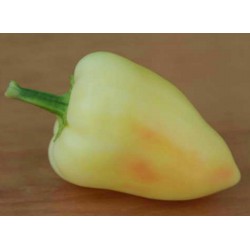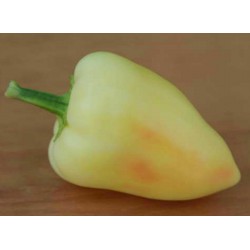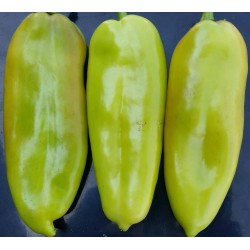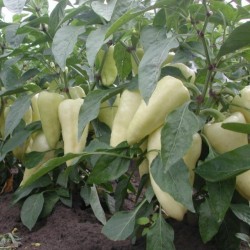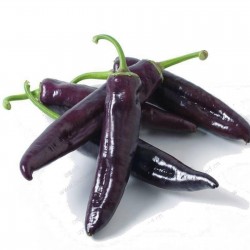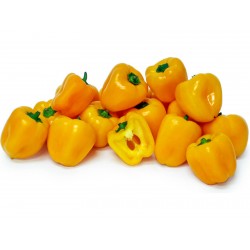Seeds Gallery EU,
5/
5
<h2 class=""><strong>"Florinis" Greece Sweet pepper Seeds</strong></h2>
<h2><span style="color: #ff0000;"><strong>Price for Package of 10 or 50 seeds.</strong></span></h2>
<p>Greece Traditional sweet red peppers (known in Greece as "Florinis"), an excellent sweet taste! Variety florin, length 23 - 28 cm and weight 200 g per fruit. In Greece, this pepper is prepared in various ways, from filling to salad and preservation. It's free to say that the table without this favorite pepper in Greek is unthinkable. Plants are fertile and highly resistant to disease.</p>
<h2 class="elementor-heading-title elementor-size-default"><strong>Chalkidiki Olives stuffed with Florina pepper</strong></h2>
<p><span>Strips of red fleshy sweet pepper, cut by hand to be filled in Chalkidiki green olives. It is the perfect dish for lovers of mild but slightly spicy, sweet and savory flavors. All these flavors together are present in olive of Chalkidiki, stuffed with red sweet pepper and can accompany each menu.</span></p>
<h3><strong>WIKIPEDIA:</strong></h3>
<p>The<span> </span><b>Florina pepper</b><span> </span>(Greek:<span> </span><span lang="el" xml:lang="el">πιπεριά Φλωρίνης</span>) is a<span> </span>pepper<span> </span>cultivated in the northern Greek region of<span> </span>Western Macedonia<span> </span>and specifically in the wider area of<span> </span>Florina; for which it is named. It has a deep red color and is shaped like a cow's horn. Initially, the pepper has a green color,<span> </span>ripening<span> </span>into red, after the<span> </span>15th of August. The red pepper is known in<span> </span>Greece<span> </span>for its rich sweet flavor, used in various Greek dishes and is exported in various canned forms abroad, usually hand-stripped, keeping the natural scents of pepper and topped with extra virgin olive oil, salt, and vinegar.</p>
<h2><span class="mw-headline" id="History">History</span></h2>
<p>The seed was brought from<span> </span>Brazil<span> </span>to<span> </span>Western Macedonia<span> </span>in<span> </span>Greece<span> </span>in the 17th century and cultivated by the local<span> </span>Macedonian Greeks<span> </span>in<span> </span>Florina,<span> </span>Prespes,<span> </span>Veroia,<span> </span>Aridaia, and<span> </span>Kozani<span> </span>but only in Florina, its cultivation was successful, where it adapted to the Greek Macedonian climate and soil, and eventually, the other regions stopped cultivating the pepper, leaving Florina as its sole producer.<sup id="cite_ref-kathimerini_1-1" class="reference">[1]</sup><span> </span>The pepper belongs to the<span> </span>capsicum<span> </span>genus of the nightshade family<span> </span>Solanaceae.<sup id="cite_ref-test2_3-0" class="reference">[3]</sup><span> </span>Florina's red peppers were awarded the recognition of<span> </span>Protected Designation of Origin<span> </span>in 1994 by the<span> </span>World Trade Organization<span> </span>(WTO).<sup id="cite_ref-test14_4-0" class="reference">[4]</sup><span> </span>Every year during the last days of August, in a small local village in<span> </span>Aetos, Florina<span> </span>a feast of peppers is held, including celebrations with music bands and cooked recipes, based on peppers which are offered to all the guests.<sup id="cite_ref-test4_5-0" class="reference">[5]</sup></p>
<h2><span class="mw-headline" id="Cultivation">Cultivation</span></h2>
<p>High productivity and adaptation of the plant can be achieved in efficient draining soils, full sunny locations and low winds for the protection of its branch and root sensitivity.<sup id="cite_ref-test12_6-0" class="reference">[6]</sup><span> </span>The most convenient temperatures for its growth are between 20° to 26°<span> </span>Celsius<span> </span>during the midday and 14° to 16° Celsius during the night.<sup id="cite_ref-test2_3-1" class="reference">[3]</sup><span> </span>Their harvest takes up to 18 weeks,<span> </span>ripening<span> </span>to maturity after mid-August.<sup id="cite_ref-kathimerini_1-2" class="reference">[1]</sup><span> </span>A good quality, red pepper of Florina should be bright in color, thick, firm and sweet flavored. Its consumption should be avoided with the appearance of dullness, cracks or deterioration, which are factors of the<span> </span>vegetable<span> </span>reduction in quality.</p>
<h2><span class="mw-headline" id="Cooking_and_recipes">Cooking and recipes</span></h2>
<p>The red peppers of Florina are usually<span> </span>roasted<span> </span>and<span> </span>stuffed<span> </span>with different combinations of<span> </span>foods, as<span> </span>rice,<span> </span>meat,<span> </span>shrimps<span> </span>and<span> </span>feta cheese.<sup id="cite_ref-macsaveur_8-0" class="reference">[8]</sup><span> </span>These<span> </span>sweet peppers<span> </span>are used in<span> </span>sauces,<span> </span>salads,<span> </span>pasta, meat recipes or mashed, creating a<span> </span>pâté<span> </span>with traditional recipes. They can also be<span> </span>dried,<span> </span>canned,<span> </span>frozen<span> </span>and<span> </span>pickled, usually<span> </span>garnishing<span> </span>Greek salads.<span> </span>They can be roasted, sliced and served as an appetizer, by adding<span> </span>olive oil,<span> </span>garlic<span> </span>and<span> </span>sea salt.<span> </span>A well-known traditional recipe in<span> </span>Greece<span> </span>with stuffed peppers is<span> </span>Gemista.</p>
<script src="//cdn.public.n1ed.com/G3OMDFLT/widgets.js"></script>
PP 26 (10 S)

